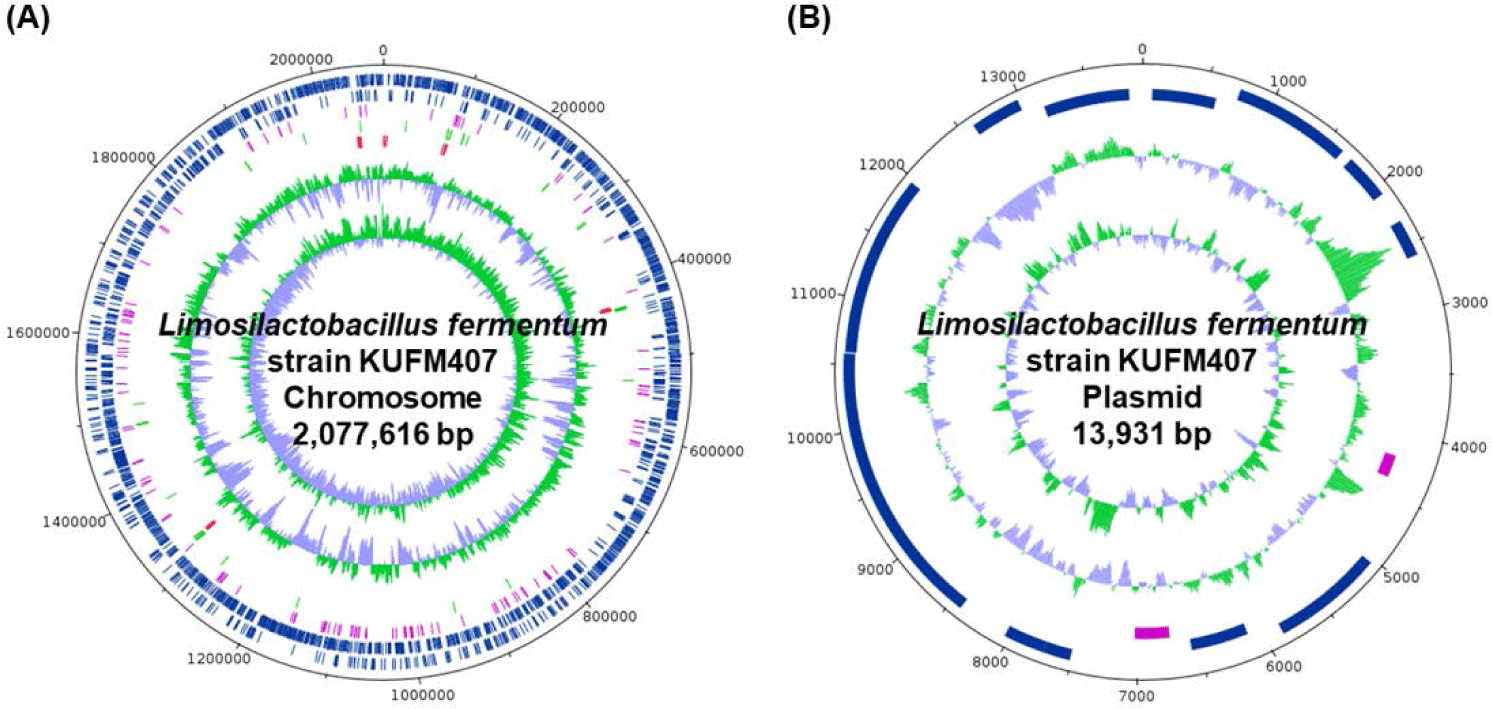Limosilactobacillus fermentum has been widely used in the fermentation of various foods and is considered a strain with high probiotic potential. Probiotics are “live microorganisms that, when administered in adequate amounts, confer a health benefit on the host” [1]. Strains of L. fermentum have high survival rates in the gastrointestinal tract. They strongly attach to enterocytes and produce antimicrobial compounds. In addition, L. fermentum has been shown to benefit host and human health by regulating immune responses and improving intestinal health.
For lactic acid bacteria (LAB) to act as functional probiotic strains, properties such as the ability to adhere to mucosal surfaces and resistance to low pH and high bile concentrations are required [2]. For acid tolerance confirmation, 0.1 mL aliquots of each active culture were inoculated in 10 mL De Man–Rogosa–Sharpe (MRS) broth (BD, Franklin Lakes, NJ, USA) broth acidified to pH 2.5 and supplemented with 1,000 U mL−1 of porcine pepsin (Sigma-Aldrich, St. Louis, MO, USA). The samples were then incubated at 37°C for 3 h. To determine bile salt tolerance, 0.1 mL aliquots of each active culture were inoculated in 10 mL MRS broth containing 0.3% oxgall bile salt (Sigma-Aldrich) and incubated at 37°C for 24h. Following incubation, cell suspensions were spread on MRS agar plates, and viable cell counts were determined through plate counting methods. L. fermentum KUFM407 (KUFM407) showed high stability against acid and bile salts (Table 1).
KUFM407 obtained from the Food Microbiology Laboratory, Division of Food Bioscience and Technology, Korea University (Seoul, Korea) was cultivated in MRS broth for 24h at 37°C and sub-cultured three times before the extraction of genomic DNA (gDNA).
Subcultured strains were washed three times with PBS buffer, and 1 mL aliquots of the washed strains were adjusted to the OD600 range of 1.0 to 2.0. Exgene™ Cell SV (Geneall, Seoul, Korea) was used to extract gDNA after gram-positive bacteria-specific pretreatment. The presence of a single strain of KUFM407 was confirmed by gel electrophoresis and 16S rRNA sequencing.
The extracted gDNA was prepared for short-read sequencing using an Illumina® DNA Prep Kit (Illumina, San Diego, CA, USA). Short-read sequencing was performed on an Illumina MiSeq sequencer using the Illumina MiSeq® Reagent Kit v3 (Illumina), resulting in paired-end reads of 300 base pairs (bp) in length. A long-read sequencing library was prepared using an Oxford Nanopore Ligation Sequencing Kit (Oxford Nanopore, Oxford, UK). Long-read sequencing was performed on a MinION sequencing device (Oxford Nanopore) using an R9.4.1 flow cell (Oxford Nanopore). Illumina short-read sequencing yielded 1,699,990 paired-end reads (419,571,925 bp), and Oxford Nanopore long-read sequencing produced 53,365 reads totaling 298,111,808 bp.
The draft genome sequence was constructed from the long reads using Flye assembler (v. 2.9.2) [3] after two polishing iterations. Adapter sequences were removed, and short reads were quality controlled using TrimGalore (v. 0.6.7) [4] in paired-end mode. The quality of the draft genome assembly was improved by error correction with PolyPolish (v. 0.5.0) [5] using quality controlled short reads. Genome and functional annotations of predicted genes were performed using the Prokaryotic Genome Annotation Pipeline (v. 6.4) [6]. Genome completeness was assessed with BUSCO (v. 5.4.6) [7] using the Lactobacillales _odb10 dataset. Default parameters were used for all software unless otherwise noted.
The complete genome sequence of KUFM407 consisted of a circular chromosome (2,077,616 bp) with a guanine + cytosine (G+C) ratio of 51.5% and a circular plasmid sequence of 13,931 bp (Table 2). The genome was 99.7% complete. A total of 2,143 genes, including 1,932 protein-coding, 15 rRNA, and 58 tRNA genes, and 135 pseudogenes were predicted in the genome sequence (Fig. 1). Biological functions were assigned to 1,729 (89.5%) of the protein-coding genes. The most assigned proteins were associated with replication, recombination and repair; amino acid transport and metabolism; translation, ribosomal structure and biogenesis; transcription; and carbohydrate transport and metabolism (207, 170, 155, 137, 123 genes, respectively).
| Length (bp) | GC (%) | Depth | CDSs | tRNA | rRNA | |
|---|---|---|---|---|---|---|
| Chromosome | 2,077,616 | 51.5 | 122.0 | 1,920 | 58 | 15 |
| Plasmid | 13,931 | 40.5 | 36.0 | 12 | 0 | 0 |
| Total | 2,091,547 | 51.4 | 121.4 | 1,932 | 58 | 15 |

In the plasmid sequence of KUFM407, four genes (garQ, garI, garC, garD) known to be involved in the production of the garvicin Q family class II bacteriocin were found [8]. Also, fatty acid biosynthetic gene cluster was identified in the chromosome and short-chain fatty acids such as acetate, propionate, and butyrate produced by gut microbes are known to have anti-inflammatory effects [9] (Table 3). The genomic information of L. fermentum KUFM407 could provide insights for future research on the characteristics of this strain as a functional food and health supplement.
